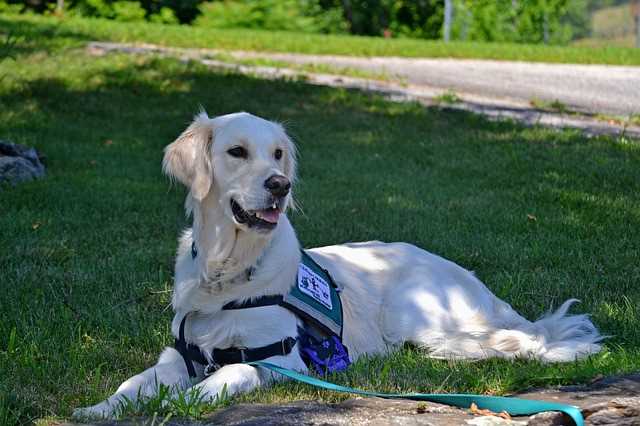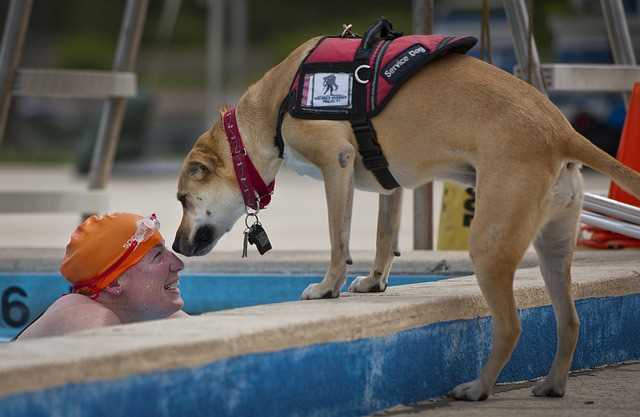Types of Assistance Dogs: (Service, Therapy, Emotional Support)
Types of Assistance Dogs
By Tasha Williams |Published June 17, 2019
You don’t need to be told that your small pooch is as smart as a whip. On a similar note, you probably know just how much love, joy, and energy your little pup brings into your life. Considering these facts, it is no wonder that dogs are frequently trained as assistance animals.
Different Types of Assistance Dogs

However, what most people don’t realize is that there are actually different types of assistance dogs. Since they fall under related terms, though – service, therapy, and emotional support – this can often cause a great deal of confusion.
Well, while the labels may sound interchangeable, the functions are not. In this article, you will have a greater understanding of how one type of assistance dogs differ from another.
What is a Service Dog?
The term people are most familiar with is “service dog.” So, let’s start by taking a look at what this means. There are actually quite a few regulations surrounding this type of assistance pup. This is because they fall under the American Disabilities Act, Title III.
In short, these animals are trained to perform tasks or activities for an owner with a disability. These dogs are not considered pets. Also, considering their function, they are required to undergo rigorous training. Some of the typical duties of a service dog include:
What are the Different Types of Service Dogs?
 Types of Assistance Dogs: Service Animals
Types of Assistance Dogs: Service Animals- Act as a guide dog for people with vision impairments
- Work as hearing dogs for individuals with hearing loss or impairments
- Assist people with mobility difficulties or who are in wheelchairs
- Detect extreme blood sugar levels in diabetics
- Respond to and help people diagnosed with seizure disorders
- Assists individuals with autism
- Psychiatric service dogs help individuals with a specific psychiatric disorder
Service Dogs and Your Legal Rights
Perhaps one of the ways service dogs really stand out from therapy and emotional support pups is that they have more legal rights. Or, rather, their owners are afforded greater permissions when it comes to housing, restaurants, and airlines.
Since service dogs fall under the purview of the ADA, all housing owners, restaurants, businesses, and hotels must permit the dogs to enter their premises. Any business or organization owner is only allowed to ask two questions regarding service animals:
- Is the dog required as a service animal because of a disability?
- What work or task has the dog been trained to perform?
Once these questions have been answered satisfactorily, owners can’t be questioned about their dog’s abilities or their own disability.
However, service dogs must be either on a leash, harness, or some other type of tether. In short, the dog has to be under the owner’s control at all times. Also, registering a dog can make it a lot easier for others to identify a pup as such and allow owners easier access.
Service Dog Training
As mentioned, service pups have to undergo intense training, often from a very young age. Of course, some older dogs can also be taught how to perform the necessary tasks. It really does depend on the person.
In many instances, it can take up to two years to thoroughly train a particular pooch. The level and period of training are determined by the tasks they are expected to perform. The more services a pup has to perform, the longer he or she will need to be trained.
Some people choose to train their own service animals. In most cases, though, these dogs are trained by organizations. This can be a rather pricey venture, with the training costing up to $25,000 in certain situations.
Types of Assistance Dogs: What is a Therapy Dog?
 Therapy Dogs are yet another of the many types of assistance dogs
Therapy Dogs are yet another of the many types of assistance dogsNow, let’s move onto therapy dogs and what they do for people. While service animals are expected to only interact with their owner or handler, it is the complete opposite with a therapy dog. Here, the dogs are expected to work with any number of people who aren’t their handler.
Therapy dogs are often used to provide psychological and physical boosts to people. Therefore, it is common to find them in the following institutions:
Where do Therapy Dogs Work?
- Schools
- Group homes
- Rehabilitation centers
- Hospitals
- Nursing homes
- Hospices
Therapy Dogs and the Law
Unlike with service dogs, therapy dogs don’t have the kind of access and permission that service dogs do. This is because while the ADA does recognize therapy dogs, there aren’t special laws written for them. As such, businesses and organizations can deny access to these pups.
That being said, you are allowed to register your therapy dog as such. Various establishments will certify that a particular dog can be classified as a therapy dog as long as the training requirements are met. Even then, there may be limitations as to where therapy dogs will be allowed.
Therapy Dogs and Training
The main requirements for therapy dogs are that they are friendly, have good manners, and are great with people. They also need to be good-natured and allow people to interact with and pet them. Due to this, there is limited training involved for therapy pups.
However, if the therapy dog is going to assist people with specific issues like physical rehabilitation or psychiatric illnesses, they may need to receive specialized training. Apart from that, though, most pets can be trained to be therapy animals.
Therapy Dogs and Health Maintenance
One area therapy dogs do have to be up-to-date on is health maintenance. Since they have to interact with children, old people, and everyone in between, it is incredibly vital that they are healthy.
This means that therapy animals need to receive their vaccinations and rabies shots like clockwork. They also have to undergo annual checkups such as heartworm and fecal examinations. These pups may also be required to be on preventative medication in certain instances.
Types of Assistance Dogs: Emotional Support Dogs
 Emotional Support Animals are also included in our list of Types of Assistance Dogs
Emotional Support Animals are also included in our list of Types of Assistance DogsLast but certainly not least are emotional support dogs. Now, things can get rather confusing when discussing these types of pups. This is because most people use the term to generalize any kind of animal that offers emotional support.
Of course, as you know, this can essentially refer to all dogs! Technically, an ESA must provide some type of comfort to an individual suffering from an emotional or psychological disorder. These dogs shouldn’t be confused with psychiatric service dogs, nonetheless.
Psychiatric service dogs are trained to physically help their owner who is suffering from a certain mental health disorder. Emotional support dogs, on the other hand, provide comfort but aren’t actually trained in any specific way.
Emotional Support Dogs and the Law
Since ES dogs don’t fall under the ADA, there aren’t too many legal protections for them. Still, if emotional support dogs do have certain rights, thanks to the Fair Housing Act and Air Carrier Access Act.
Thus, there are many apartment buildings and housing organizations that will allow you to keep your dog as long as you have the proper documents. However, you will have to be responsible for any damages or similar issues resulting from keeping your pet in your home.
As for airline laws, you should find several airlines that are willing to have your dog onboard with you. Regarding the fees for doing so will depend on the airline. A few may waive this fee while others will have you cover it.
Despite all this, it is not uncommon to face quite a few battles with an emotional support animal. This is because it can be quite tricky to define and test what an ESA must actually do. Therefore, quite a few businesses and organizations may turn people away.
An easy way to cut through the hassle is to get a certification stating that your dog is, in fact, a registered emotional support animal. To receive this, however, a psychologist or psychiatrist will need to verify that your dog provides you with noticeable support, depending on your condition.
Emotional Support Dogs and Training
For the most part, emotional support dogs don’t have to receive any training. Many people can gain a sense of comfort and calm, by merely having their dogs around them. In certain instances, though, your emotional support dog may need to be trained.
This really depends on the condition they are assisting you with. For instance, if you tend to have anxiety attacks or tend towards self-harm, then an ESA must be taught how to cuddle or help with such behaviors.
Takeaway for Types of Assistance Dogs
As you can see, there is a lot more to service, therapy, and emotional support dogs than you might have initially imagined. Each of these assistance dogs is unique and wonderful. However, there are also several differences between each one.
It is important to understand the discrepancies, particularly if you are considering getting an assistance animal for yourself or a loved one. By being able to grasp how each dog functions, you will be better equipped to make a more informed decision. In turn, both you and your pooch are more likely to be happy. Now, of course, you can do just this, thanks to everything you have learned.
Author Bio (Types of Assistance Dogs)
Tasha Williams has been an animal trainer for over ten years. During this time, she has cared for and trained several service, therapy, and emotional assistance dogs. She has also been instrumental in pairing dogs and their owners. She continues to provide advice on the subject, based on her past experience.
Does This Article Deserve Your Thumbs Up?
We always appreciate your support and encouragement. Your thumbs up means so much to us. Please like this article.
If you find this page or any page on Small Dog Place Helpful, or Useful in anyway, I’d love it if you would click the small heart found on the bottom right of each page.
You can also share or bookmark this page — just click on the:

Free Monthly Newsletter
Sign Up for Our Free Newsletter and get our Free Gift to You.
my E-book, The Top 10 Mistakes People Make When Choosing a Dog (and how to avoid them)




